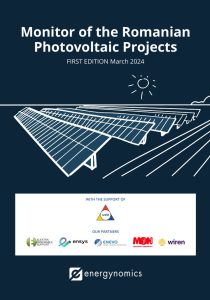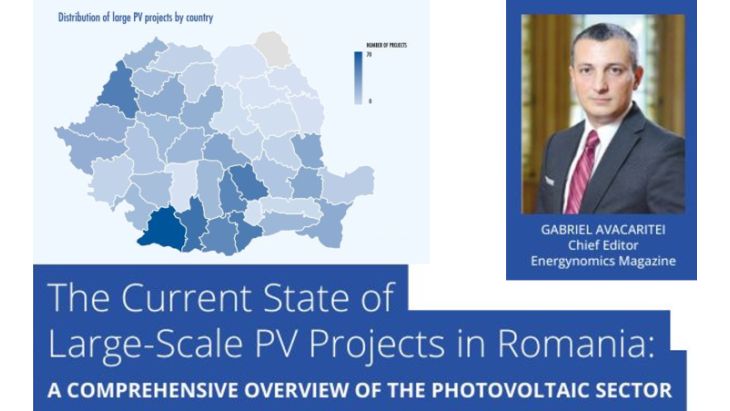Romania has set ambitious targets for developing renewable energy sources, including solar power. This article provides a comprehensive overview of the current state of large-scale PV projects in Romania, covering project details, readiness levels, key players, and the overall impact on the energy sector and the environment. We took into consideration PV projects with installed capacity larger than 5 MW, meant to inject the power into the grid. We gathered and curated the essential information on them and we rated the projects based on a 10-stages rating system we designed – Project Maturity Rating, starting from 01 – Concept and licenses prior to ATR, to 10 – Decommissioning & recycling / Re-Powering. (Read more in the Methodology section!) Here are some considerations based on this research.

Romania has made significant strides in developing large-scale photovoltaic (PV) projects, contributing to its renewable energy goals. As of the latest data available, there are over 880 large-scale PV projects in Romania, boasting a cumulative capacity of approximately 46,600 MW. This impressive number showcases the country’s commitment to harnessing solar energy as a clean and sustainable source of power.
Regarding project size, there is a diverse range of installations, catering to various needs and locations. Projects with a capacity of 20 MW or less form the majority (390), accounting for a significant portion of the total number (44.02%). They sum up a total capacity of 3.566 MW, which is 7.65% of the total capacity. However, 115 projects above 100 MW also play a crucial role, contributing a substantial share to both the total number of projects (12.98%) and the cumulative capacity (55.21%).
Almost a third of the charted projects are in the slice 20 to 50 MW each, and they total 9.322 MW, which is around 20% of the total.
This mix of project sizes ensures a balanced and flexible approach to solar energy deployment.
The sheer number of projects, their cumulative capacity, and the geographical distribution paint a picture of a sector that is rapidly expanding and contributing to Romania’s clean energy future.
Regional Distribution of Large-Scale PV Projects in Romania: A Closer Look
The regional distribution of large-scale PV projects in Romania reveals a notable concentration in certain counties, indicating areas with favorable conditions for solar energy development.
Dolj and Arad: Leading the Solar Charge
There are five counties with more than 50 PV projects in our data set – Dolj, Olt, Giurgiu, Prahova, Bihor, and 9 counties with less the 5 PV projects. There is only one in Neamț and Suceava, two in Vaslui and Vâlcea, respectively.
Regional distribution of these projects reveals a concentration in the southern and western areas of the country. Dolj (70) and Olt (56) stand out as the frontrunners, hosting a substantial number of large-scale PV projects. Other counties, such as Prahova (51), Giurgiu (51), Bihor (50), Dambovita (46) and Teleorman (45) are also worth mentioning because of the number of projects identified.
This concentration in these counties highlights their suitability for solar energy generation, potentially due to favorable weather conditions, land availability, and supportive local policies.
13 counties contribute significantly to the overall capacity, each with over 1 GW in projects identified. Arad (5.40 GW) and Dolj (5.39 GW) are the most promising locations, but counties such as Giurgiu (4), Bihor (3.8), Teleorman (2.6), Timis (2.3) and Dambovita (2.3) also stand out in this respect. This geographical diversity highlights the potential for solar energy development across Romania.
Geographical Diversity Fosters Balanced Development
The regional distribution of large-scale PV projects in Romania demonstrates a commendable level of geographical diversity. The presence of projects in various counties indicates a concerted effort to harness solar energy potential throughout the country. This balanced approach ensures that the benefits of solar energy are not limited to specific regions and promotes a more equitable distribution of clean energy generation.
Categorizing Romania’s Large-Scale PV Projects by Installed Capacity
The landscape of large-scale PV projects in Romania encompasses a wide range of installed capacities, catering to diverse energy needs and project objectives. By categorizing these projects based on their installed capacity, we gain insights into the scale and scope of solar energy deployment in the country.
Megawatt Giants: Leading the Clean Energy Charge
At the forefront of Romania’s solar energy revolution are the six projects with installed capacities exceeding 500 megawatts (MW): Arad Sud (500 MW), Socol, Arad (509 MW), Ogrezeni, Giurgiu (550 MW), Salard, Bihor (595 MW), Gighera, Dolj (721 MW) and Arad 1, Arad (1.065 MW) These mega-projects represent significant investments in renewable energy infrastructure, capable of generating substantial amounts of clean electricity. Their presence signals Romania’s potential to transitioning fast to a sustainable energy future.
Large-Scale Contributors: Driving the Energy Transition
The 115 projects with installed capacities ranging from 100 to 499 MW also play a crucial role in Romania’s solar energy landscape. 20 of them are over 300 MW each and are distributed in 9 counties.
These large-scale projects contribute significantly to the country’s overall solar generation capacity, demonstrating the scalability and versatility of solar energy. Their presence underscores the growing adoption of solar power as a viable and cost-effective energy source.
Mid-sized Projects: Paving the Way for Decentralized Energy
In addition to the large-scale projects, Romania has witnessed the emergence of smaller PV projects with installed capacities between 50 and 100 MW. These 130 mid-scale ventures will contribute to the country’s solar energy mix, promoting decentralized energy generation and encouraging local communities to embrace solar solutions. Their presence, with a total of over 8 GW in installed capacity, highlights the inclusivity of Romania’s solar energy push, allowing for diverse stakeholders to participate in the clean energy transition.
The Cumulative Impact: A Brighter Energy Future
The collective capacity of Romania’s large-scale PV projects, encompassing the megawatt giants, multi-megawatt contributors, and small-scale pioneers, paints a promising picture of the country’s renewable energy progress. Over 640 projects under 50 MW each means another 12.88 GW to be added to the Romanian PV capacities to be injected into the grid.
This diverse portfolio of projects showcases the scalability, adaptability, and potential of solar energy in meeting Romania’s energy needs. The cumulative installed capacity represents a significant step towards a cleaner, more sustainable energy future for the country.
Big promises for the near future
The data shows that 2024 and 2025 might witness a surge in the completion of large-scale photovoltaic (PV) projects in Romania, with over 400 projects expected to contribute significantly to the country’s goals. Their total capacity is estimated at 30.5 GW.
Obviously, this is the trickiest area in this report. For most of the projects, this piece of information is the estimated year of their entering into operation as appears in the public documents released by the TSO and the DSOs. However, it is widely known and accepted that the PIF date communicated by the project developer is nothing more than a targeted horizon. Phases like the elaboration of the solution study to obtain the Technical Approval for Connection (ATR) might take many months. Even when the project obtained the technical connection notice (ATR) and the connection contract (CR), sometimes the developer delays signing the contract taking its time to secure the most convenient financial scheme. Even after reaching the ready to build phase, other delays might appear in the processes of procurement and contracting, and also, although with less probability, in the construction period.
The most advanced the project – beyond PMR 4, for example, the better is the estimate regarding the year when the PV project will enter into operation.
Thus, only a small portion of the promises in the first paragraph will be completed within these timeframes. However, this will mark a strong of step towards achieving 6 GW of solar power capacity by 2030.
Out of the top 50 largest PV projects planned for completion by 2030 or earlier, 12 are poised to be finalized in 2024 (3.961 MW). Most of them are still in the initial PMR stages. 25 are set to be completed in 2025 (8.192 MW), and only three of them are in the PMR 4 stage, which means they have secured the establishment authorization from ANRE. The remaining projects are either still in the planning stage or have a PIF beyond 2026. The total capacity of these projects nearing completion is substantial and will play a pivotal role in Romania’s renewable energy targets.
The completion of these projects will underscore Romania’s commitment to transitioning towards sustainable energy sources and reducing its reliance on fossil fuels. The large-scale PV projects will provide clean, renewable energy, contributing to the country’s energy security and environmental sustainability.
Moreover, these projects will stimulate economic growth and create employment opportunities in the renewable energy sector. As Romania continues to prioritize the development of renewable energy sources, the successful completion of these PV projects in 2024 and 2025 will serve as a significant milestone in the country’s journey towards a greener and more sustainable energy future.
Projects Maturity Distribution
The photovoltaic projects in Romania are at varied stages of development, with many still in the early planning and permitting phases. We used a 10-steps scale named Project Maturity Rating to describe the project maturity from the inception to decommissioning or repowering phase.
As of February 2024, there are 886 projects we discovered with a combined capacity of 46,643 MW in Romania. Among these projects, 642 are in the early stages of development (PMR 1), accounting for a total capacity of 38,111 MW. Meanwhile, over 75 are nearing the ready-to-build phase (PMR 2-3), with a total capacity of 4,893 MW.
60 projects are in the construction phase (PMR 4-7), totaling 2.300 MW, and lastly, 4 projects (31 MW) are in the testing phase (PMR 8). 101 projects we monitor, with a total capacity of 1,277 MW, are in the O&M phase.
Compared with the situation a few years ago, significant progress is being made, with numerous projects nearing the construction and final stages of development.
The distribution of projects across the different stages of development highlights the Romanian PV sector’s infancy. Likewise, the current edition of Energynomics’ “Monitor of the Large-Scale PV Projects in Romania” is a first step towards building a better image of an industry in full sprint. Thank you all for your contribution and we count on working together for improving not only this tool, but the general context for a more and more powerful PV industry in Romania.

